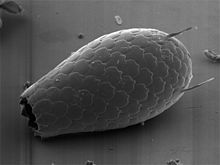Ventrifilosa (from Latin venter 'belly' and filum 'thread')[2] is a highly diverse group of phagotrophic protists that glide through their flagella and emit filose pseudopods from their ventral side for feeding. Because of their mixture of amoeba and flagellate characteristics, they are amoeboflagellates. Members of this group are the Imbricatea, Sarcomonadea and Thecofilosea.[1]
| Ventrifilosa | |
|---|---|

| |
| Euglypha | |
| Scientific classification | |
| Domain: | Eukaryota |
| Clade: | Diaphoretickes |
| Clade: | SAR |
| Phylum: | Cercozoa |
| Subphylum: | Monadofilosa |
| Superclass: | Ventrifilosa Cavalier-Smith, 2012 emend. 2018[1] |
| Classes | |
Morphology
editProtists in the group Ventrifilosa ancestrally have a rigid extracellular theca on the dorsal side, and emit non-granular filose pseudopods from a ventral aperture. This aperture is called "cleft" when belonging to an amoeboflagellate, or "astropyle" when belonging to a phaeodarian.[2]
The group includes descendants that have lost or modified some of these characteristics. For example, some have lost their pseudopods (such as the spongomonads and Ebria), some have lost their theca (such as Pseudopirsonia), and some have acquired axopodia (in Phaeodaria). The loss of flagella and scales has occurred in this group several times independently through evolution.[2][3]
Taxonomy
editThe superclass Ventrifilosa was first described in 2012 by Cavalier-Smith to unite Thecofilosea and Imbricatea.[2] However, the group proved to be polyphyletic because the sarcomonads were excluded. Later, in 2018, it was expanded to include Sarcomonadea, which belonged to the superclass Eoglissa before this change.[1]
The current classification of Ventrifilosa recognizes 3 classes, 20 orders and 60 families.[1]
- Class Sarcomonadea Cavalier-Smith 1993 stat. nov. 1995 emend. 2018
- ?Family Katabiidae Cavalier-Smith 2012
- Subclass Paracercomonada Cavalier-Smith 2018
- Order Paracercomonadida Cavalier-Smith 2018
- Subclass Pediglissa Cavalier-Smith 2012
- Order Cercomonadida Poche 1913 emend. Cavalier-Smith
- Order Glissomonadida Howe et al. 2009
- Class Imbricatea Cavalier-Smith 2003 emend. 2018
- Subclass Placonuda Cavalier-Smith 2012
- Superorder Nudisarca Cavalier-Smith 2012
- Order Variglissida Cavalier-Smith 2014
- Order Marimonadida Cavalier-Smith & Bass 2011
- Superorder Euglyphia Cavalier-Smith 2018
- Order Euglyphida Copeland 1956 emend. Cavalier-Smith 1987
- Order Zoelucasida Cavalier-Smith 2014
- Superorder Discomonada Cavalier-Smith 2018
- Order Discomonadida Cavalier-Smith 2014
- Superorder Nudisarca Cavalier-Smith 2012
- Subclass Placoperla Cavalier-Smith 2012
- Superorder Placofila Cavalier-Smith 2012
- Order Thaumatomonadida Shirkina 1987
- Order Discocelida Cavalier-Smith 1997
- Superorder Perlatia Cavalier-Smith 2012
- Order Spongomonadida Hibberd 1983
- Order Perlofilida Cavalier-Smith 2012
- Superorder Placofila Cavalier-Smith 2012
- Subclass Krakenia Cavalier-Smith 2018
- Order Krakenida Dumack et al. 2017 ex Cavalier-Smith 2018
- Subclass Placonuda Cavalier-Smith 2012
- Class Thecofilosea Cavalier-Smith 2003 emend. 2012
- Subclass Ventricleftia Cavalier-Smith 2018
- Order Ventricleftida Cavalier-Smith 2011
- Subclass Eothecia Cavalier-Smith 2012
- Order Matazida Cavalier-Smith 2012
- Order Ebriida Deflandre 1936
- Order Cryomonadida Cavalier-Smith 1993
- Subclass Phaeodaria Haeckel 1879
- Order Eodarida Cavalier-Smith 2012
- Order Opaloconchida Cavalier-Smith 2012
- Subclass Tectosia Cavalier-Smith 2012
- Order Tectofilosida Cavalier-Smith 2003
- Subclass Ventricleftia Cavalier-Smith 2018
References
edit- ^ a b c d Cavalier-Smith, Thomas; Chao, Ema E.; Lewis, Rhodri (April 2018). "Multigene phylogeny and cell evolution of chromist infrakingdom Rhizaria: contrasting cell organisation of sister phyla Cercozoa and Retaria". Protoplasma. 255 (5): 1517–1574. doi:10.1007/s00709-018-1241-1. PMC 6133090. PMID 29666938.
- ^ a b c d Cavalier-Smith T, Karpov SA (2012). "Paracercomonas Kinetid Ultrastructure, Origins of the Body Plan of Cercomonadida, and Cytoskeleton Evolution in Cercozoa". Protist. 163 (1): 47–75. doi:10.1016/j.protis.2011.06.004. ISSN 1434-4610. PMID 21839678.
- ^ Howe AT, Bass D, Scoble JM, Lewis R, Vickerman K, Arndt H, Cavalier-Smith T (2011). "Novel Cultured Protists Identify Deep-branching Environmental DNA Clades of Cercozoa: New Genera Tremula, Micrometopion, Minimassisteria, Nudifila, Peregrinia". Protist. 162 (2): 332–372. doi:10.1016/j.protis.2010.10.002. ISSN 1434-4610. PMID 21295519.